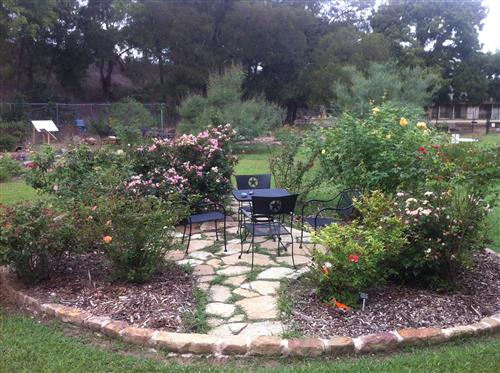- East Fort Worth Montessori Academy
- Learning Gardens
Outdoor Learning
Page Navigation
-
Outdoor Learning Gardens
The Butterfly Garden
The Butterfly Garden at East Fort Worth Montessori is a sanctuary for the endangered Monarch butterfly. The butterfly migrates North from Mexico as the seasons begin to shift from the cold splintering days of winter to the warm soothing days of Spring. On their journey, they stop by EFWMA to lay their eggs, eat some milkweed and continue their journey to Canada. As Fall approaches, the Monarchs make their way back South and again visit our school. As the children are eating their lunches from the dining hall, they can peer outside and see the metamorphosis and migration of the Monarch butterfly unfold.The LabyrinthThe Labyrinth at East Fort Worth Montessori is a meditative experience for all. With one way in and one way out the Labyrinth reflects the journey to finding a potential solution in a sea of possibilities. As people walk through they inch towards the center experiencing the sight of blooming flowers, germinating seeds, the smell of various herbs, and with the noise of Nature in the background.
The Labyrinth dates back to prehistoric times and is perceived as a very special place for meditation across many cultures such as the Celtic, Mayan, Greek, and Native Americans.The Rose Garden
 The Rose Garden began with the planting of peace roses by the families of East Fort Worth Montessori Academy and the Ameen People Montessori Islamic School.In 2007, Sharing Our Cultures and Teaching Tolerance Photo Exchange engaged the students in diverse project activities founded on the principals of experiential education. It integrated the Texas Essential Knowledge and Skills of reading and writing with photography. Over twelve weeks, photography was taught as an art and an end in itself. The project consisted of a partnership with East Fort Worth Montessori Academy and the Ameen People Montessori Islamic School. The schools worked in developing a positive relationship between Muslim and non-Muslim families and learned to respect and value their differences and similarities. In May 2007, the students and families celebrated and shared stories about their activities through an exhibition of the journals they created through the project.We believe the project was a success. Over the twelve weeks, the students were attentive, engaged and their excitement was evident in their eagerness to begin work. Students were able to define and identify tolerance while refining their communication skills. They also practiced organizing, presenting, and expressing their thoughts and ideas through photography.The lessons from these types of projects are not always visible. However, if we can exercise this type of practice within ourselves and each other with tolerance at the heart of our interactions, then peace is obtainable.
The Rose Garden began with the planting of peace roses by the families of East Fort Worth Montessori Academy and the Ameen People Montessori Islamic School.In 2007, Sharing Our Cultures and Teaching Tolerance Photo Exchange engaged the students in diverse project activities founded on the principals of experiential education. It integrated the Texas Essential Knowledge and Skills of reading and writing with photography. Over twelve weeks, photography was taught as an art and an end in itself. The project consisted of a partnership with East Fort Worth Montessori Academy and the Ameen People Montessori Islamic School. The schools worked in developing a positive relationship between Muslim and non-Muslim families and learned to respect and value their differences and similarities. In May 2007, the students and families celebrated and shared stories about their activities through an exhibition of the journals they created through the project.We believe the project was a success. Over the twelve weeks, the students were attentive, engaged and their excitement was evident in their eagerness to begin work. Students were able to define and identify tolerance while refining their communication skills. They also practiced organizing, presenting, and expressing their thoughts and ideas through photography.The lessons from these types of projects are not always visible. However, if we can exercise this type of practice within ourselves and each other with tolerance at the heart of our interactions, then peace is obtainable.The Pond
In 2006, East Fort Worth Montessori Academy embarked on the creation and enhancement of a schoolyard natural habitat. Part of this habitat includes the pond, which was built as a collaborative project with students' parents, and Tray Bradley's landscape company. In November of 2006, it was built with the intent of helping students learn about the aquatic ecosystems in a man-made environment, learn about the characteristics of aquatic plants and animals, study water pollution and water conservation, study how aquatic animals care for their young, and how they protect themselves from predators.

